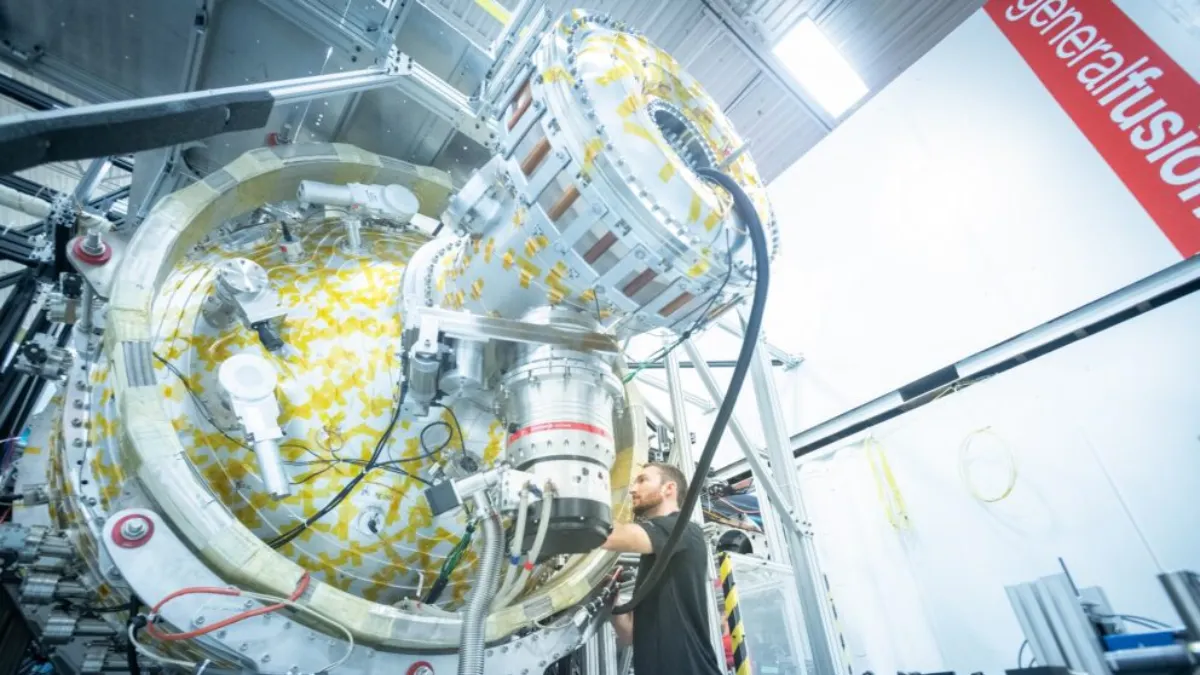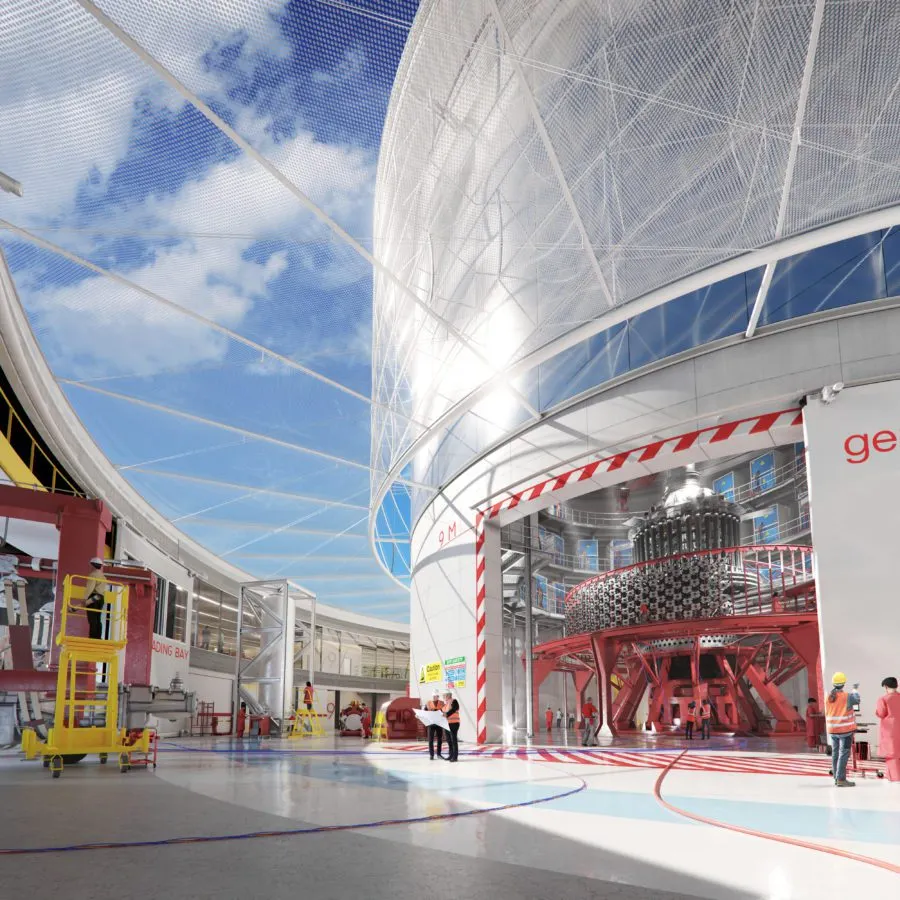General Fusion announces new fusion demo machine
By Leigh Ann Kesler & Melanie Windridge
General Fusion announced plans to build a new magnetised target fusion (MTF) device on Wednesday 9th August. This new device will be constructed at their Richmond, Canada, headquarters to demonstrate fusion conditions at scale.
So, what have they done and how significant is it?

The plasma injector (PI3) has already achieved the temperature and energy confinement times required by LM26 © General Fusion
What have they done?
General Fusion has made a strategic shift and announced they will be building an intermediate fusion device in Canada before constructing their Fusion Demonstration Plant (FDP) at UKAEA’s Culham Campus in England.
The Fusion Demonstration Plant, which received UK planning approval earlier this year, was due to commence construction this summer, be commissioned in 2026 and fully operational by early 2027. It would be 70 per cent scale of a commercial power plant, designed to create fusion conditions in a power plant-relevant environment, achieving temperatures of over 100 million degrees Celsius.
Now they plan to achieve these key fusion milestones in a new device and delay the UK Fusion Demonstration Plant by a couple of years. When built, however, this device will be closer to a commercial scale facility and incorporate a number of commercial plant features that were not originally planned for this machine.
In their recently completed Series F funding, they raised $25M from both private investors and new grant funding from the Government of British Colombia, which builds upon the Canadian government's ongoing support via the Strategic Innovation Fund (SIF). This funding will support construction of the new device, Lawson Machine 26 (LM26) at the company headquarters in Richmond, British Columbia.
Greg Twinney, CEO of General Fusion, said, “Our updated three-year Fusion Demonstration Program puts us on the best path forward to commercialize our technology by the 2030s. We’re harnessing our team’s existing strengths right here in Canada and delivering high-value, industry-leading technical milestones in the near term.”
Why is this impressive?
Like many fusion companies, General Fusion has acquired funding to build an intermediate-sized device that will allow them to “de-risk” on their path to a demonstration device.
General Fusion has been developing Magnetised Target Fusion (MTF) technology since 2002. MTF differs from the approaches of magnetic and inertial confinement fusion, which require large magnet and laser systems, respectively, to generate the temperatures and pressures required for self-sustaining fusion. MTF attempts to incorporate the advantages of both magnetic and inertial fusion designs while avoiding some of the technological challenges.
In General Fusion’s design, the fusion plasma is injected into a spinning liquid-metal cylinder, which is then compressed with pistons, bringing the plasma to the temperature and pressure required for fusion to occur. In a power plant the process would be rapidly repeated as the energy from the fusion neutrons is absorbed by the liquid metal, then transferred to another fluid for electricity generation.
The new device, Lawson Machine 26 (LM26), is designed to about half the scale of a commercial fusion device, similar to the scale of other demonstration devices . LM26 will use the existing operational plasma injector (PI3), developed by General Fusion, with a new lithium liner compression system to reach new milestones on their path to fusion.
LM26 will run deuterium fuel (instead of deuterium-tritium fuel as planned for a power plant) and so is not planned to actually reach energy breakeven, only breakeven equivalent. Instead, it will allow General Fusion to demonstrate the temperatures necessary for fusion (100 million degrees Celsius, around 10 keV) by 2025, and the conditions required for breakeven by 2026.

The fusion demonstration facility designed by architect Amanda Levete. © General Fusion.
Why is it important?
Zoltan Tompa, Senior Partner, BDC Capital’s Climate Tech Fund II said: “The new LM26 machine represents a capital efficient steppingstone to de-risk their Fusion Demonstration Program while accelerating the delivery of critical milestones such as fusion conditions and energy breakeven.”
LM26’s results will validate the company’s ability to compress magnetised plasmas in a repeatable manner and achieve fusion conditions at scale. It aims to fast-track their technical results and go beyond what was initially planned for the UK device.
This step integrates well with the agreement between General Fusion and the UK Atomic Energy Authority (UKAEA) to build the Fusion Demonstration Plant (FDP) at the Culham campus in England. General Fusion says that, over the next two to three years, the team will work closely with the UK Atomic Energy Authority to validate the data gathered from LM26 and incorporate it into the design of the FDP.
After FDP, General Fusion plans to commercialise their design by building a First Of A Kind power plant to put electricity on the grid in the early- to mid-2030s.
What’s next?
If LM26 is to produce fusion temperatures by 2025, there should be rapid construction at the site in Richmond, which will likely lead to interesting news reports on construction progress as well as components’ and systems’ testing.
The design for the Fusion Demonstration Plant will be largely based on the results of the experiments in LM26, so the details of that design should begin to evolve in the next two to three years. In addition, the collaboration between General Fusion and the UKAEA will likely result in other stepping stones on the path to FDP and beyond.
